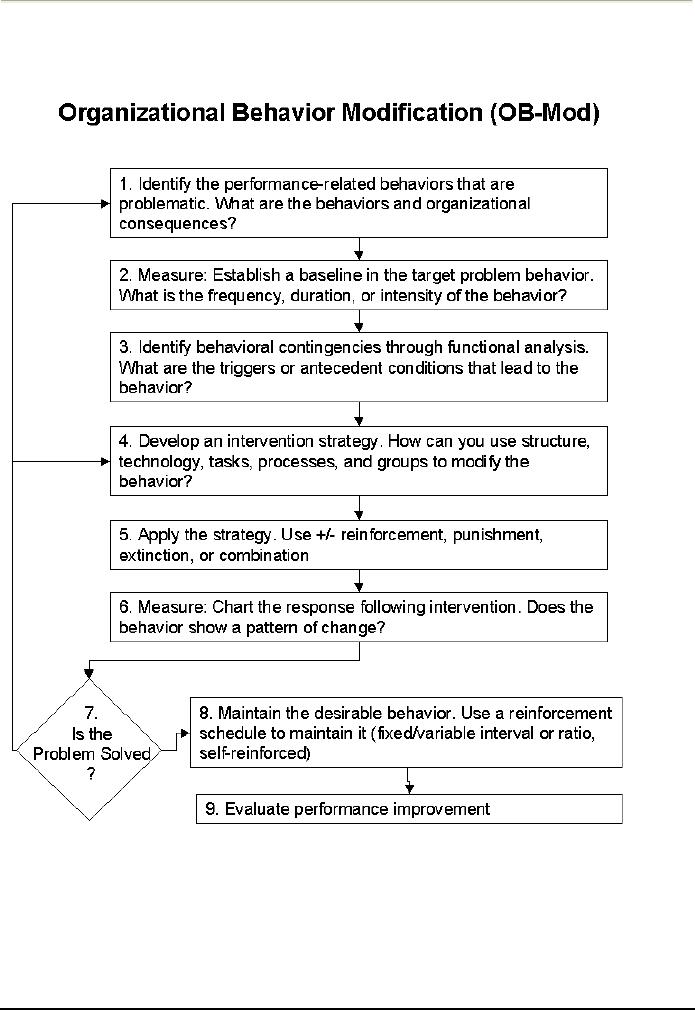 |

Organizational
Psychology (PSY510)
VU
LESSON
41
OBMOD
OBMOD
or Organizational Behaviour Modification is a program
where managers identify
performance-
related
employee behaviour and then
implement an intervention strategy to
strengthen desirable
performance
behaviour and weaken undesirable
behaviours.
It
combines the works of Pavlov, Skinner, Luthans
and Bandura. OBMOD is the
application of
reinforcement
theory to people in organizational settings.
Reinforcement theory says that we
can increase
the
frequency of desirable behaviour by
linking those behaviours
with positive consequences
and decrease
undesirable
behaviour by linking them with
negative consequences. OBMOD
characteristically uses
positive
reinforcements
to encourage desirable behaviours in
employees.
The
typical OBMOD program follows a five
step problem solving model:
1.
Identification of performance related
behaviours
2.
Measurement of the behaviours
3.
Identification of behavioural
contingencies
4.
Development and implementation of an
intervention strategy
5.
Evaluation of performance
improvement
Everything
an employee does on his or
her job is not equally
important in terms of performance
outcomes.
The
first step in OBMOD, therefore, is to
identify the critical behaviours that
make a significant impact on
the
employee's job performance.
These are those 5 to 10
percent of behaviours that
may account for up to
70
to 80 percent of each employee's
performance.
The
second step requires the
manager to develop some baseline
performance data. This is obtained
by
determining
the number of times the identified
behaviour is occurring under present
conditions.
The
third step is to perform a
functional analysis to identify the
behavioural contingencies or
consequences
of
performance. This tells the
manager the antecedent cues
that emit the behaviour and
the consequences
currently
maintaining it.
Once
the functional analysis is complete, the
manager is ready to develop and implement
an intervention
strategy
to strengthen desirable performance
behaviours and weaken
undesirable behaviours.
The
appropriate
strategy will entail changing
some element of the performance-reward
linkage-structure,
processes,
technology, groups or the task--with the
goal of making high-level performance
more rewarding.
The
final step in OBMOD is to
evaluate performance improvement. If the
performance has increased,
the
manager
must try to maintain the desirable
behaviour through some
schedule of positive reinforcement.
For
example,
higher commissions might be granted
for every other sale,
for sales over a certain
rupee amount,
and
so forth.
Finally,
the manager looks for improvements in
individual employees' behaviour.
Here the emphasis is on
offering
significant longer-term rewards, such as
promotions and salary
adjustments, to sustain
ongoing
efforts
to improve performance.
OBMOD
has been used by a number of
organizations to improve employee
productivity and to
reduce
errors,
absenteeism, tardiness, and
accident rates. OBMOD has
also proven effective in
sports
organizations.
The philosophy behind OBMOD
additionally appears to be affecting many
managers in the
way
they related to their employees--in the
kind and quantity of
feedback they give, the content of
performance
appraisals and the type and allocation or
organizational rewards.
Despite
the positive results that
OBMOD has demonstrated, it is
not without its critics. Is
it a technique for
manipulation
people? Does it decrease an
employee's freedom? If so, is
such action on the part of
managers
unethical?
And do non-monetary reinforcers like
feedback, praise, and
recognition get stale after a
while?
Will
employees being to see these as a
way for management to
increase productivity without
providing
commensurate
increases in their pay? There
are no easy answers to
questions such as
these.
This
approach to motivation and
dealing with problem
behaviors is based on the application of
learning
theory
to people in the workplace. Reinforcement theory holds
that a desirable behavior
can be increased by
linking
that behavior with positive
outcomes, while undesirable
behaviors can be decreased by
linking them
with
negative consequences or by eliminating
reinforcers. The advantage of this
approach is that it
focuses
on
specific behaviors in the workplace and
is thus performance based. It
also, at least to some
degree,
avoids
sensitive personal counselling
issues in a person's personal
life, by focusing on what needs to
be
done
to improve performance. Finally, it
provides a clear structure and
consequences to employees
that
142

Organizational
Psychology (PSY510)
VU
encourage
them to change in an observable way in a
structured time frame. The model
below outlines the
stages
of its use:
This
relatively simple and straight forward
approach has been used in a
variety of organizations with
varying
rates
of success. For example,
B.F. Goodrich has used
OB-Mod to increase productivity by
more than
300%,
and Weyerhauser increased
productivity in three different
groups by 8%. However, a program
initiated
by Standard Oil of Ohio was
discontinued due to failure to meet
objectives, and A Michigan
Bell
program
was considered only modestly
successful.
143

Organizational
Psychology (PSY510)
VU
Applications
of OBMOD
Following
are some of the applications of OBMOD
that have been identified
through research:
1.
Behaviour of manufacturing and service
organizations improves through OBMOD
program.
2.
Employee productivity improves through
OBMOD program.
3.
A reduction in absenteeism of up to 18-50% is
seen through OBMOD
programs.
4.
OBMOD programs have resulted
in 90% decrease in tardiness.
5.
Safety, accident prevention: 33%
reduction, lot of money saved on
medical bills and thus
organizational
time
saved.
6.
Sales performance improves due to
OBMOD programs.
Correcting
Group Dysfunctions
Dysfunctions
of groups refer to the negative functions
of groups. These include the following
four:
1.
Norm Violation
2.
Group Think
3.
Risky Shift
4.
Social Loafing
Following
are some of the techniques of correcting
group dysfunctions:
Shaping
When
managers attempt to mould individuals by
guiding their learning in graduated
steps, we are shaping
behaviour.
Consider the situation in which an
employee's behaviour is significantly
different from that
sought
by management. If management only
reinforced the individual when he or she
showed desirable
responses,
very little reinforcement might be taking
place. In such a case,
shaping offers a logical approach
toward
achieving the desired
behaviour.
We
shape behaviour by systematically
reinforcing each successive
step that moves the
individual closer to
the
desired response. If an employee
who has chronically been a
half hour late for
work comes in only 20
minutes
late, we can reinforce this improvement. Reinforcement
would increase as responses
more closely
approximate
the desired behaviour. The
procedure for shaping is as
follows:
1.
Chart:
Define
desired behaviour
2.
Reward:
responses
that approximate desired
behaviour
3.
Use
differential reinforcement: to
refine each step and
reinforce desired behaviour.
Management
by Objectives
Another
method for correcting group dysfunctions
is through the process of MBO. It
includes the
following
five steps:
1.
Setting overall
objectives
2.
Developing organization
3.
Setting individual
goals
4.
Periodic reviews
5.
Final Appraisal
OBMOD
The
third method of correcting group
dysfunctions is through OBMOD programs.
It includes the
following
steps:
1.
Identify
2.
Measure
3.
Analyze
4.
Intervene
5.
Evaluate
REFERENCES
�
Luthans,
Fred. (2005). Organizational Behaviour (Tenth
Edition). United States:
McGraw Hill Irwin.
�
Mejia,
Gomez. Balkin, David &
Cardy, Rober. (2006). Managing Human
Resources (Fourth
Edition).
India:
Dorling Kidersley Pvt. Ltd.,
licensee of Pearson Education in South
Asia.
�
Robbins,
P., Stephen. (1996). Organizational
Behaviour (Seventh Edition). India:
Prentice Hall, Delhi.
�
Huczynski,
Andrzej & Buchanan, David.
(1991). Organizational Behaviour: An Introductory
Text
(Second
Edition). Prentice Hall. New
York.
144

Organizational
Psychology (PSY510)
VU
�
Moorhead,
Gregory & Griffin, Ricky. (2001).
Organizational Behaviour (First Edition).
A.I.T.B.S.
Publishers
& Distributors. Delhi.
�
OBMOD;
The effectiveness of OB-MOD.:
http://faculty.css.edu/dswenson/web/OB/obmod.html
FURTHER
READING
�
O.B.
Mod. File Format:
http:/www.haworthpress.com/store/E-
Text/View_EText.asp?sid=164BXA9MAK1N9PGCFVQ4XXCR76Q6ATN7&a=3&s=J075
�
What
is Organizational Behavior Management/OBM?:
http://www.behavior.org/psa/whatisobm.cfm
�
Organizational
Behavior Management: What it is and
how to do it: A management
handbook. New
York:
Pergamon Press. Redmon, W.
K., & Agnew, J. L.
(1991a):
http://www.obmnetwork.com/resources/articles/ABA2004br/Austin_WhatHow.ppt
�
Organizational
Behavior and Modification:
http://www.management-hub.com/hr-behavior.html
145
Table of Contents:
- INTRODUCTION TO ORGANIZATIONAL PSYCHLOGY:Hawthorne Effect
- METHODOLOGIES OF DATA COLLECTION:Observational method, Stability of Measures
- GLOBALIZATION:Aspects of Globalization, Industrial Globalization
- DEFINING THE CULTURE:Key Components of Culture, Individualism
- WHAT IS DIVERSITY?:Recruitment and Retention, Organizational approaches
- ETHICS:Sexual Harassment, Pay and Promotion Discrimination, Employee Privacy
- NATURE OF ORGANIZATIONS:Flat Organization, Neoclassical Organization Theory
- ORGANIZATIONAL CULTURE:Academy Culture, Baseball Team Culture, Fortress Culture
- CHANGING ORGANIZATIONAL CULTURE:Move decisively, defuse resistance
- REWARD SYSTEMS: PAY, Methods of Pay, Individual incentive plan, New Pay Techniques
- REWARD SYSTEMS: RECOGNITION AND BENEFITS, Efficiency Wage Theory
- PERCEPTION:How They Work Together, Gestalt Laws of Grouping, Closure
- PERCEPTUAL DEFENCE:Cognitive Dissonance Theory, Stereotyping
- ATTRIBUTION:Locus of Control, Fundamental Attribution Error
- IMPRESSION MANAGEMENT:Impression Construction, Self-focused IM
- PERSONALITY:Classifying Personality Theories, Humanistic/Existential
- PERSONALITY ASSESSMENT:Standardized, Basic Categories of Measures
- ATTITUDE:Emotional, Informational, Behavioural,Positive and Negative Affectivity
- JOB SATISFACTION:The work, Pay, Measurement of Job Satisfaction
- MOTIVATION:Extrinsic motive, Theories of work motivation, Safety needs
- THEORIES OF MOTIVATION:Instrumentality, Stacy Adams’S Equity theory
- MOTIVATION ACROSS CULTURES:Meaning of Work, Role of Religion
- POSITIVE PSYCHOLOGY:Criticisms of ‘Traditional’ Psychology, Optimism
- HOPE:Personality, Our goals, Satisfaction with important domains, Negative affect
- EMOTIONAL INTELLIGENCE:EI IS Related To Emotions and Intelligence
- SELF EFFICACY:Motivation, Perseverance, Thoughts, Sources of Self-Efficacy
- COMMUNICATION:Historical Background, Informal-Formal, Interpersonal Communication
- COMMUNICATION (Part II):Downward Communication, Stereotyping Problems
- DECISION MAKING:History, Personal Rationality, Social Model, Conceptual
- PARTICIPATIVE DECISION MAKING TECHNIQUES:Expertise, Thinking skills
- JOB STRESS:Distress and Eustress, Burnout, General Adaptation Syndrome
- INDIVIDUAL STRESSORS:Role Ambiguity/ Role Conflict, Personal Control
- EFFECTS OF STRESS:Physical Effects, Behavioural Effects, Individual Strategies
- POWER AND POLITICS:Coercive Power, Legitimate Power, Referent Power
- POLITICS:Sources of Politics in Organizations, Final Word about Power
- GROUPS AND TEAMS:Why Groups Are Formed, Forming, Storming
- DYSFUNCTIONS OF GROUPS:Norm Violation, Group Think, Risky Shift
- JOB DESIGN:Job Rotation, Job Enlargement, Job Enrichment, Skill Variety
- JOB DESIGN:Engagement, Disengagement, Social Information Processing, Motivation
- LEARNING:Motor Learning, Verbal Learning, Behaviouristic Theories, Acquisition
- OBMOD:Applications of OBMOD, Correcting Group Dysfunctions
- LEADERSHIP PROCESS:Managers versus Leaders, Defining Leadership
- MODERN THEORIES OF LEADERSHIP PROCESS:Transformational Leaders
- GREAT LEADERS: STYLES, ACTIVITIES AND SKILLS:Globalization and Leadership
- GREAT LEADERS: STYLES, ACTIVITIES AND SKILLS:Planning, Staffing